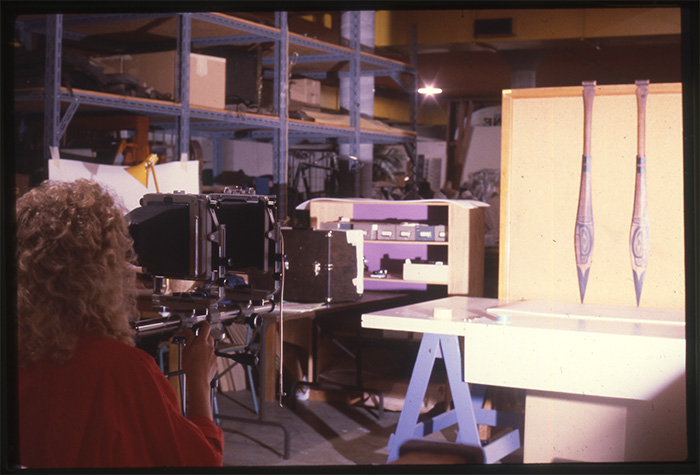Photographic Techniques
Many historical Northwest Coast paintings, particularly on house screens and bentwood boxes, are faded and worn, or are obscured by a patina of dried oils and soot. The original vibrancy of their black and red paints may be difficult to discern with the naked eye, yet traces of the pigments may still be present. Cleaning the surface is not an acceptable solution since this would remove materials that may still yield valuable information about the object’s use and age. But when these paintings are photographed with infrared film, a transformation takes place: images that appeared lost or faded emerge from beneath their patina to become visible once again.

Jacquie Gijssen photographing two paddles, ca. 1983. MOA Archives image a060333.
Infrared film is sensitive to the infrared radiation, or heat, that even small traces of paint and other pigments either absorb or reflect when illuminated with visible light. Paints vary in their pigments and media and so will vary in the way they absorb or reflect infrared radiation. Old, dense, mineral-based pigments, such as hematite (red) and magnetite (black), absorb heat. Pigments that were acquired through trade, such as Chinese vermilion, reflect heat, as does unpainted wood. When photographic floodlights are directed at a painted wooden object, infrared film will detect and record the painted areas differently in comparison with one another and in comparison with the unpainted wood. The old black pigment, made from magnetite, absorbs the heat from floodlights used during photography and prints as black on the infrared photographs. Red, on the other hand, is more variable in appearance, depending on its source. All mineral-based reds appear as mid-tone greys on infrared photographs, as they absorb less heat than does black pigment. Vermilion or trade-pigment red, however, appears lighter on the infrared photograph: it reflects more heat than do both mineral-based red pigments and unpainted wood. The result is a black-and-white photograph of the original painting, now visible in a range of tones, created by the heat absorption and reflection of the pigments and the wood.
The techniques developed through the Image Recovery Project and presented in The Transforming Image have inspired others to explore infrared photography of Northwest Coast artworks. Some museums have photographed belongings in their collections with excellent results. Community members have even tried it on pictographs, although the lack of control over outdoor lighting presents challenges with rock art. When Bill McLennan was photographing in the 1990s, he was using rolls of infrared film in his analog Hasselblad camera. Today it is no longer necessary to buy expensive infrared film, due to the availability of digital infrared cameras that make this technology much more accessible.

Canoe-steering paddle, attributed to the Haida. MOA A7526
The image to the left shows how infrared photography can bring out details no longer visible on a painted object. The canoe paddle blade on the left is the original, shot with standard film. The center image is the same paddle, shot with infrared film. Infrared photography brings out the elements of the painting: fine lines and cross-hatching, bolder compositional lines, and broad areas of solid black. On the right is the “recovered” image, painted on mylar by Bill McLennnan.
To learn more about the Image Recovery Project and infrared photography of artworks, see this list of resources.
